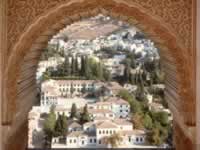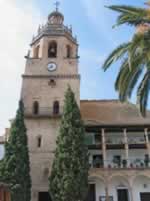Andalucia

Granada
Andalucia, one of Spain's 17 autonomous communities, was the
last Moorish stronghold before the "reconquista," which culminated
in Ferdinand and Isabella establishing Catholic rule in 1492.
Fascinating examples of Moorish architecture abound in this coastal
treasure.
Alhambra (Red Castle), sits on an expansive earthen terrace
overlooking the city of Granada. Built between 1248 and 1354, its
austere exterior belies an elegant interior graced by marble
pillars, arches, fretted ceilings and stucco filigree.
Mezquita, a 10th century Moorish Islamic mosque, was subject to
frequent invasions, and each successive conqueror contributed to
its architecture. More than 1,000 jasper, onyx, marble and granite
columns support its giant arches, and a Renaissance cathedral built
by Christian conquerors lies within. Medina Azahara, built between
936 and 961 by Caliph Abdurrahman as a tribute to his favourite
wife, az-Zahara, lies near Cordoba.

The city of Ronda,
MálagaFlamenco music, a flamboyant form of expression deeply rooted in
Moorish and Jewish tradition, originated in Andalucia and quickly
spread throughout Spanish culture. Andalucians rejoice in frequent
feast day celebrations, and visitors join in the revelry of fairs
and carnivals featuring traditional dances, colourful costumes and
delectable local dishes.
Not surprisingly, Andalucian cuisine revolves around fresh
Mediterranean seafood. Travellers on the go can stop at
"freidurias" or "cocederos," offering take-away
cooked fish. Mouth-watering cooked prawns or fried sole are served
in paper cones, the Andalucian version of fast food. Once their
appetites for food are satisfied, eager explorers set off again to
satisfy their cultural hunger for this captivating historic
land.
Provinces of Andalucia
Almeria | Cadiz | Cordoba | Granada | Huelva | Jaen
| Malaga | Seville
The Costas of Andalucia
Costa Almeria (Almeria Province) | Costa de la Luz (Cadiz &
Huelva Provinces) | Costa del Sol (Malaga Province) | Costa
Tropical (Grenada Province)